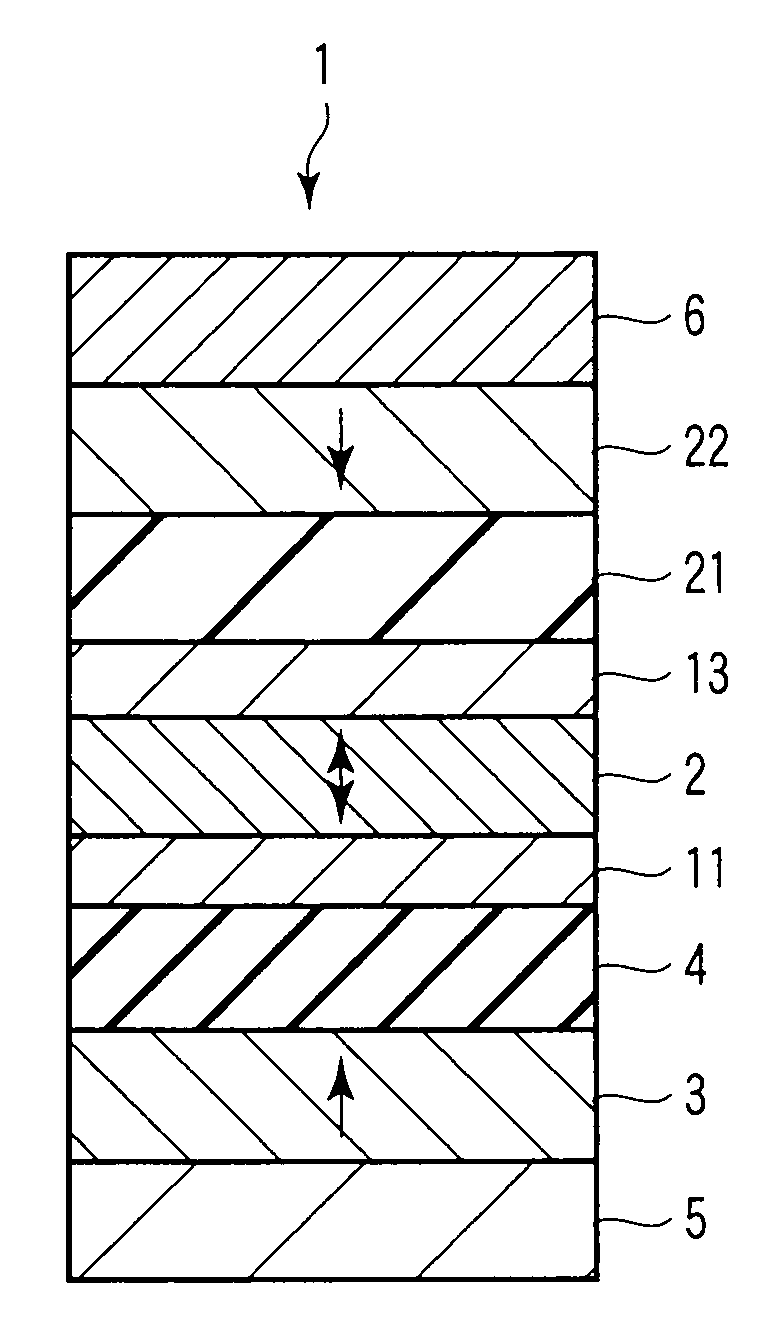Magnetoresistance effect element and magnetoresistive random access memory using the same
a random access memory and magnetoresistance effect technology, applied in the manufacture of flux-sensitive heads, solid-state devices, instruments, etc., can solve the problems of inability to allow a device to operate as a memory, inability to achieve a small cell size, and decrease in the thermal stability required for the data retention characteristics of a non-volatile memory
- Summary
- Abstract
- Description
- Claims
- Application Information
AI Technical Summary
Benefits of technology
Problems solved by technology
Method used
Image
Examples
first embodiment
[0030]The first embodiment is directed to an MR element.
(1) Structure of MR Element
[0031]FIG. 1 shows the main parts of the MR element according to the first embodiment of the present invention. FIG. 1 shows an MR element having a so-called single pin structure. Referring to FIG. 1, arrows indicate the magnetization directions. The MR element herein mentioned in this specification and in the scope of claims is a general term of a GMR (Giant MagnetoResistance) element using a metal spacer layer, and a TMR (Tunneling MagnetoResistance) element using a semiconductor or insulator as a spacer layer. Although the following figures each illustrate the major components of the MR element, another layer may also be included as long as the arrangement shown in the figure is included.
[0032]An MR element 1 has an arrangement in which each layer takes one of two steady states in accordance with the direction of an electric current flowing through surfaces (film surfaces) through which individual ...
second embodiment
[0125]The second embodiment is directed to an MRAM using the MR element of the present invention.
[0126]A spin transfer torque writing type MRAM will be explained below.
[0127]FIG. 12 is a sectional view showing the main parts of a memory cell of the MRAM according to the second embodiment of the present invention. As shown in FIG. 12, the upper surface of an MR element 1 is connected to a bit line 32 via an upper electrode 31. The lower surface of the MR element 1 is connected to a source / drain diffusion region 37a on the surface of a semiconductor substrate 36 via a lower electrode 33, conductive layer (extracting line) 34, and plug 35.
[0128]The source / drain diffusion region 37a forms a selection transistor Tr together with a source / drain diffusion region 37b, a gate insulating film 38 formed on the substrate 36, and a gate electrode 39 formed on the gate insulating film 38. The selection transistor Tr and MR element 1 form a memory cell of the MRAM.
[0129]The source / drain diffusion ...
PUM
 Login to View More
Login to View More Abstract
Description
Claims
Application Information
 Login to View More
Login to View More - R&D
- Intellectual Property
- Life Sciences
- Materials
- Tech Scout
- Unparalleled Data Quality
- Higher Quality Content
- 60% Fewer Hallucinations
Browse by: Latest US Patents, China's latest patents, Technical Efficacy Thesaurus, Application Domain, Technology Topic, Popular Technical Reports.
© 2025 PatSnap. All rights reserved.Legal|Privacy policy|Modern Slavery Act Transparency Statement|Sitemap|About US| Contact US: help@patsnap.com



